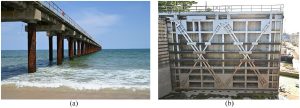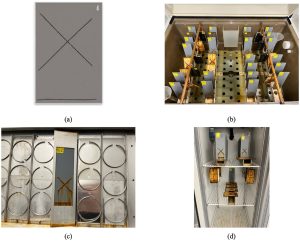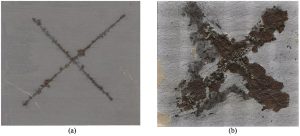NCSA-Powered AI Research Targets Corrosion Detection in Critical Infrastructure
Feb. 28, 2025 -- Corrosion is natural, and it’s everywhere. While many techniques can be applied to stave off corrosion, nothing lasts forever when exposed to the elements of nature, so consistent and planned evaluation is essential to keep the things we build working and safe.
A research team at the University of Illinois (U. of I.) led by Shengyi Wang, a Ph.D. candidate in the Department of Civil and Environmental Engineering, is using NCSA resources to help streamline the process of evaluating infrastructure for corrosion.
You probably have a bridge in your town, and you certainly have pipelines and water systems. Your city is one of tens of thousands of cities across the country – every one with infrastructure that needs to be maintained. Maintenance is costly, especially when considering how many pieces of infrastructure there are.
“Corrosion poses significant challenges to various infrastructure assets,” Wang said, “including bridges, pipelines, military equipment and water systems. It can lead to safety hazards, substantial economic losses and environmental risks. Notably, the United States allocates 40% of its National Maintenance Budget to corrosion-related repairs.”
Evaluating these various infrastructures takes a great deal of time and expertise. “Corrosion is a major issue affecting the durability and safety of critical infrastructure, leading to significant maintenance costs and safety risks,” said Wang. “Traditional corrosion assessment methods are manual, subjective, and time-consuming, requiring human inspectors to measure corrosion areas.”
It takes an expert to find corrosion, especially in its earliest stages. Something critical and subtle could be happening in the supports of a bridge, for example, that only a trained specialist could find. With as many pieces of infrastructure in the U.S. that people use every day, it’s challenging to keep up with demand. Wang’s research is a critical step in alleviating some of these issues.
“My research aims to automate and enhance corrosion detection, segmentation and measurement using a deep learning-based image segmentation model, which can improve accuracy, efficiency and consistency in corrosion analysis,” said Wang.

Examples of corrosion in USACE’s water resources infrastructure. (a) Severe corrosion of concrete-filled steel pipes in a USACE Research Facility in Duck, North Carolina. (b) Surface corrosion of a Miter gate at Marseilles Lock and Dam in Marseilles, Illinois. Credit: USACE, United States Army Corps of Engineers.
Wang’s research involves training an AI using images with and without labels. The idea is that you give some guidance to the AI, in this case, pictures of corrosion that human experts label, and then allow the AI to learn by example how to detect corrosion in unlabeled pictures. This method is called CNN-based semi-supervised learning (SSL). Wang further explains how he’s using this method in his research.
“The methodology involves collecting high-resolution digital microscopy images of corroded steel panels, which were subjected to accelerated weathering per ASTM D1654 and ISO 12944 guidelines. These images are then annotated, processed, segmented, and augmented for training. A mean teacher-based SSL method using DeepLabv3+ with a ResNet-34 backbone is employed, allowing the model to learn from both labeled and unlabeled data. Additionally, a patch-merging smoothing module is introduced to integrate high-resolution image patches seamlessly and reduce edge artifacts. The model is tested using multiple performance metrics, including precision, recall, F1-score, and IoU, and compared with state-of-the-art models.”

Steel panels subjected to extreme weathering conditions – including UV radiation, water condensation, salt fog, and freezing – to accelerate corrosion at predefined scribe marks, following ASTM D1654 and ISO 12944 standards. Credit: Shengyi Wang.
While the learning model sounds technically complex, its impact is easy to understand. Making it easier to inspect bridges could help detect corrosion in its earliest stages. As corrosion progresses, repairs become much more costly and more complex.
“My research aims to address this issue by automating corrosion assessment,” said Wang. “This automation enables early detection, thereby reducing maintenance costs. It also improves efficiency by replacing time-consuming manual inspections with an AI-driven approach. Consequently, this approach supports sustainability by extending the lifespan of critical infrastructure through optimized maintenance decision-making. This has direct implications for industries such as transportation, construction, and defense.”
Wang’s research not only has the potential to alleviate some of the pains of infrastructure maintenance but his methods could be adapted for other research uses as well. “My research provides a scalable and adaptable framework for corrosion detection that can be extended to other defect detection applications in civil infrastructure, such as crack and spalling segmentation and analysis,” he said. “The semi-supervised learning approach reduces reliance on extensive labeled datasets, making it easier to apply to other environmental conditions. Future research could build on this work by integrating real-time drone-based inspections or transformer-based models for even more robust multi-class defect detection.”

High-resolution digital microscopy images after coating removal, which capture corrosion progression for rust creep measurement. Traditionally, those panels undergo a manual and subjective process for corrosion measurement. This study leverages semi-supervised learning (SSL) to automate corrosion segmentation and measurement, improving accuracy, efficiency, and consistency in infrastructure maintenance. Credit: Shengyi Wang.
Wang’s team recently published their work in the journal Structural Health Monitoring, and the team continues to refine their work. They’ll incorporate more real-world corrosion images to enhance model generalization as they move forward. Wang also intends to make the AI more adaptable to different scenarios.
“I will also implement domain adaptation techniques to improve the model’s ability to perform well across different environments and corrosion types,” he said. “Additionally, I will explore transformer-based models for improved feature extraction and segmentation accuracy.”
Future plans include working with industry partners to test the model in the field. “I will collaborate with industry partners such as the USACE and infrastructure maintenance teams to deploy and test the AI system in real-world corrosion monitoring applications.”
Wang’s work couldn’t be completed in such a short time without the resources at NCSA. High-Performance computing helps research teams like Wang’s get their results quickly, speeding up innovation across all domains that employ research computing.
NCSA is more than just hardware, and researchers often take advantage of the Center’s deep bench of expertise. “The NCSA support team was very helpful,” explained Wang, “especially in setting up deep learning workflows and troubleshooting the Delta system as I was getting started. As a beginner in AI and high-performance computing, I had many questions about software installation and workflow setting-up. I’d like to specifically acknowledge Craig Steffen for his patience and support in guiding me through the Delta GPU setup process, ensuring everything ran smoothly.”
Source: Megan Meave Johnson, NCSA













